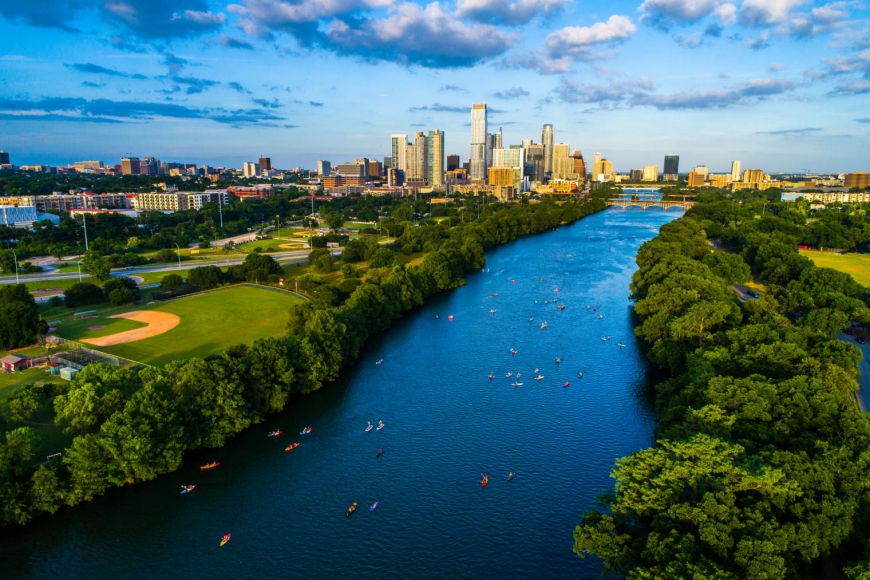Gain water stewardship insights from our decade of global experience and analysis of our 100 most recent watershed assessments.
Nearly every product manufactured or service delivered by a company requires water to make, transport, and/or use. Why then is water stewardship an increasingly important yet overlooked aspect of all business? If your access to water was impacted, how long could you operate? What if raw material supply is disrupted due to water issues? What if both occur?
Water stewardship is a business imperative today and will be into the future given global water demand is estimated to grossly exceed water supply within the next decade. In addition to not having enough water, there are also situations of having too much water (floods) and poor water quality (pollution) to consider. While some corporate leaders understand this and have stepped up to the plate to tackle water stewardship and security issues, many are largely underestimating the significance to their business. There are likely many reasons for this oversight and inaction. Some may have the perception that water is not a significant cost to justify any action, they may think they have always had a reliable supply and therefore always will, or they are a small water user and do not think that they have an impact.
Even with a perfect state of the art facility, companies cannot insulate themselves from local water supply conditions or the business pressures from regulators, customers, investors, and local communities. What we are really talking about here is short-term business continuity and long-term business resiliency.
One Watershed at a Time Journey to Extensive Data and Learnings
Over the past 15 years, Antea Group has conducted approximately 450 watershed source vulnerability assessments (SVAs) across 84 countries. We have provided corporate leaders with a cost-effective approach to achieve insight and validation of water-related risks, opportunities, and implications to their businesses. The SVA process is a comprehensive study of a particular watershed or catchment that evaluates vulnerabilities related to the management, reliability, quality, transmission, treatment and distribution of water, and the risks posed to the surrounding community that is dependent on that source water. The goal of the SVA is to pair the vulnerabilities with mitigation strategies to drive the advancement of water stewardship which when actions are taken, will bolster business continuity, resiliency, and ultimately, water security in the greater watershed.
While watershed data is available, it is commonly fragmented, not interpreted for business, biased from one perspective (e.g., water provider), and outdated. We have overcome these challenges by leveraging our global network of water experts within our sister companies and the Inogen Alliance. We have also continually refined our process and developed our best practices as we recognize there is no time for complacency!
Our resume of experience, while extensive, is a drop in the bucket as the world needs more than just current leaders embracing water to address global and local water challenges. Antea Group is on a mission to make corporate water stewardship approachable to all companies. As Antea Group’s Sustainability Practice Leader, Nick Martin, explains, “Our mission is to mainstream water stewardship within the broader business community, to help all companies realize the importance and business value of pursuing water stewardship…at a pace and intensity that fits their culture.”
SVA Differentiators
We have taken the time to reflect on our experience which has resulted in the development of our refreshed “next-generation” SVA process. We took our best SVAs and:
-
Deconstructed them.
-
Incorporated insights and best practices from our team of Subject Matter Experts.
-
Infused elements of leading frameworks (e.g. Alliance for Water Stewardship, Task Force on Climate Related Financial Disclosures.
Through this refresh, we continue to innovate, improve, and best contribute to the water stewardship narrative.
Our Insights From 100 Recent SVAs
It is this mission that is driving us to broadcast high-level findings from our 100 most recent SVAs conducted over the past few years in 38 countries. Our intent is to share this knowledge to encourage more businesses to appreciate the importance of understanding local watershed context and inspire them to take action on water. This recent collection of SVAs was consolidated through a collaboration with the Beverage Industry Environmental Roundtable (BIER), a coalition of global beverage companies and leaders within water stewardship and security.
Beverage Sector Water Leadership
Since 2006, Antea Group has facilitated the Beverage Industry Environmental Roundtable (BIER). Water has been a signature topic for the coalition since day one and understanding watershed context is foundational in all of BIER’s efforts. Notable achievements include:
Framework for Water Stewardship in the Beverage Industry
Context-Based Decision Guide for Water Reuse and Recycling
WBCSD/BIER Water Circularity Metric
For more information on BIER, visit: www.bieroundtable.com
This collection of SVAs spans across the globe and covers 38 countries, as highlighted in dark blue on the map.
-
450+ SVAs completed over 15 years in 84 countries (light blue)
-
100 SVAs completed within the last 2 – 3 years in 38 countries (dark blue)
We categorized the risk profile of each SVA according to eight water risk categories which included physical risks related to the amount and quality, the transmission and management, regulatory risks associated with compliance and tariffs, and social/reputational risks associated with WASH (water, sanitation, and hygiene) and the social license to operate. Each risk category was further assigned a subset of vulnerabilities, for a total of 33 subcategories, to aid in a better analysis of risk drivers. Note that these risk categories and vulnerability subcategories were not weighted prior to the analysis as risk definitions can be unique to each business.
The table shows the percentage breakdown according to the aggregate risk profile. The top three risk categories include not having enough water (24 percent), water quality (20 percent), and business continuity planning (18 percent).
Vulnerability Category |
Percent of Vulnerabilities |
| Physical Risk - Too Little Water | 24% |
| Physical Risk - Water Quality | 20% |
| Business Continuity Planning | 18% |
| Basin Governance | 12% |
| Regulatory | 11% |
| Water Supply Infrastructure | 8% |
| Social/Reputational/WASH | 5% |
| Physical Risk - Too Much Water | 3% |
Drilling down into the subcategories, a total of 781 vulnerabilities were identified within the SVA collection. Of these 781 vulnerabilities, the top ten (out of 33) most common risk categories include:
- Watershed and incoming water quality
- Droughts
- Basin management /planning
- Increasing community water demand
- Alternative water supply options
- Watershed deficit/scarcity
- Infrastructure reliability and losses (non-revenue water)
- Increases in water tariffs
- Groundwater depletion
- Increasing regulations
This high-level snapshot of data collected from 100 watersheds within 38 countries is certainly not a complete picture of the global water crisis. However, our intent is to add to the narrative that already exists that local validation is needed to fully understand how the business community impacts and depends on the watersheds where they operate.
Considerations For Impact Mitigation
As businesses take the time to evaluate their risk exposure and create action plans, we often advise looking inside and outside of the “four walls.” Key considerations for action could include:
- Tracking monthly water usage and water quality data (incoming and outgoing)
- Ensuring water is used efficiently for production, processing, sanitation, irrigation, and employee needs
- Evaluating opportunities for reusing and recycling water
- Educating employees on water awareness and to actively manage changing conditions locally
- Tracking local water supply quantity and quality conditions to maintain awareness of potential issues
- Preparing a plan for emergencies (e.g. natural disasters, water reduction/loss, etc.)
- Analyzing water use and water risk in your supply chain
- Engaging with community stakeholders, including water service providers, municipalities, local and national non-governmental organizations that are working to advance water security
- Testing the feasibility of collective action with other water users in the community
This list is by no means exhaustive, but it is a good start! Want more water stewardship and security insights? Check out Antea Group’s “One Watershed at a Time” webinar series.
Want to pursue SVA related initiatives? Here are three ways:
- Commission an SVA with the focus on ensuring source water protection for your high-risk facilities and identifying potential opportunities to support broader watershed and community needs.
- Look for a partner(s) to conduct a joint SVA. Collaborate on shared water challenges to achieve impact at a greater scale.
- Bring together multiple public and private stakeholders on shared water challenges to collaborate on integrated solutions and sustainable finance mechanisms.
Learn more about our water stewardship service here. If you are looking to pursue these initiatives, contact us.
Want more news and insights like this?
Sign up for our monthly e-newsletter, The New Leaf. Our goal is to keep you updated, educated, and even a bit entertained as it relates to all things EHS and sustainability.
Get e-NewsletterHave any questions?
Contact us to discuss your environment, health, safety, and sustainability needs today.







